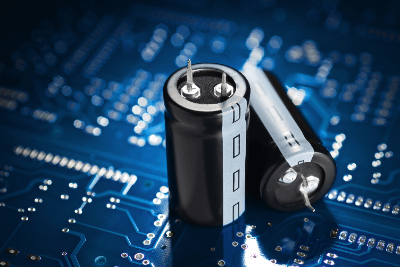What Is a Capacitor?
A capacitor is a component consisting of a substance that does not conduct electricity sandwiched between two metal plates.
Generally, capacitors have two functions: to store an electric charge and to advance alternating current.
Uses of Capacitors
Capacitors are used in a wide range of applications, from home appliances to industrial equipment. They are always an integral part of products with electronic circuits. Specific applications of capacitors are as follows:
- Control boards for air conditioners, refrigerators, and other air conditioning equipment
- Control boards for water heaters
- Control boards for TVs and recorders
- Power devices for power factor correction in substations
- Computer control platforms and AC adapters
Principle of Capacitors
A capacitor is a component with a dielectric between two metal electrodes. When a DC voltage is applied between the two electrodes of a capacitor, an electric charge is stored in the electrodes because it cannot exceed the dielectric.
The stored charge initially behaves as if there is apparent continuity between the two poles. As the charge gradually saturates, the capacitor behaves as if it is completely open between the two poles. This is the principle of the capacitor.
Due to these properties of capacitors, they are used for the following:
- Backup Power Source: By releasing the stored charge, it can serve as a temporary backup power source.
- Voltage Smoothing: Pulse current can be smoothed by storing or releasing an electric charge; AC adapters, for example, use this feature.
- Noise Removal and Extraction of Some Frequency Voltages: Noise can be eliminated by smoothing out the voltage in the frequency band that causes noise. If a resonance circuit is fabricated with a coil, it is possible to take out only some of the frequency band signals.
Types of Capacitors
There are several types of capacitors, including electrolytic capacitors, film capacitors, and electric double-layer capacitors.
1. Electrolytic Capacitor
Surface treatment is applied to the metal anode to form an oxide film, which serves as the dielectric. For the cathode, an aqueous electrolyte solution or the like is used. The most common anode material is aluminum, etc., due to its performance and price.
2. Film Capacitor
Metal foil or vapor-deposited metal is used for the electrode. The dielectric material is a plastic film. Film capacitors have no polarity and can be used in AC circuits.
3. Electric Double Layer Capacitor
Electric double layer capacitors do not use a dielectric. Instead, a boundary layer called an electric double layer is used to store an electric charge.
Other Information on Capacitors
1. How to Read the Capacitance of a Capacitor
Capacitor performance is expressed in terms of capacitance. The unit of capacitance is pF or μF, with pF being the most common, except for large capacitors.
The reading of capacitance varies depending on whether the capacitance is greater than or equal to 100 pF, less than 100 pF, or if R is used in the display. 100 pF or greater has a trailing number that represents a multiplier. For example, a “541” capacitor is 54 x 10¹ = 540 pF.
If less than 100pF, just read the number as it is; if R is used, replace R with a decimal point. For example, a “4R7” capacitor is 4.7 pF. Tolerances for capacitors are also written in the alphabet.
In the case of “B,” ±0.5 pF is represented for 10 pF or less, and ±0.1% for 10 pF or more. For example, “102J” capacitor is 10 x 10²±5% = 950pF to 1,050pF.
2. Capacitor Life
Capacitors are composed of alternating layers of electrodes and dielectrics. The dielectric contains electrolytes to increase the capacitance, which evaporates over time. This is called dry-up, and the life of an ultracapacitor ends when the electrolyte inside is drained.
Therefore, the life of an ultracapacitor is affected by the ambient temperature. When the ambient temperature rises by 10°C, the evaporation rate is approximately doubled. Conversely, if the temperature drops by 10°C, the evaporation rate is about 1/2 times faster.
General capacitors are specified at 105°C for 2,000 hours. If the ambient temperature drops by 10°C, the service life is 4,000 hours, and if the ambient temperature drops by 30°C, the service life is approximately 1.8 years. Capacitors also self-heat due to electric current. This temperature rise also affects the service life, so it must be taken into consideration.
In addition, the life of an ultracapacitor depends on the applied voltage. At the rated voltage, the capacitor can be seen, but when overvoltage or reverse voltage is applied, a chemical reaction occurs at the electrodes, shortening the life span.
